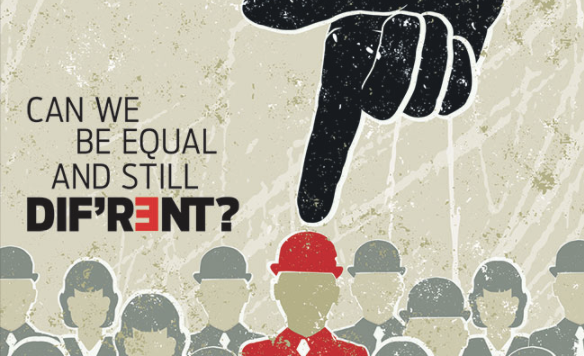
A well-known Victorian actress, Mrs. Patrick Campbell, once famously remarked about homosexuals that she didn’t care what they did as long as they didn’t do it in the streets and frighten the horses. Just when American society is beginning to adjust slowly to the idea of same-sex marriage without stampeding, I would like to introduce another idea that might make the horses restless: it’s true, there are some essential differences between gay and straight people, and those differences might hold the key to the gay future.
For the past 150 years of gay and lesbian intellectual history, the primary split regarding identity has been between the ideas of gay assimilation and gay essentialism.
Gay assimilation says that the only difference between heterosexuals and homosexuals are a few perverse sexual practices, otherwise, homosexuals are just like heterosexuals. There are no other basic differences. Gay assimilationists accept the sexual orientation model of gay identity, an identity based on same-sex sexual behavior.
Gay essentialism says that being gay is important, that gays contribute in a uniquely essential way to society, and that we are just beginning to understand that contribution. This new awareness started in Los Angeles, is stronger on the West coast, and is global in scope. For gay essentialists, a sex-centric identity represents the tail wagging the dog.
The term “homosexual” became a sex-negative identity that was laid on gay people in the 19th century by their oppressor, the dominant culture enforcing rigid heterosexual supremacy and conformity. During the past half-century, most gay and lesbian political work has involved successfully changing that sexual orientation model from a sex-negative one to sex-positive, a considerable achievement. But the tail is still doing the wagging.
Let’s be frank. As pleasurable as it may be, it’s hard to build a substantive identity based on an act of same-sex fellatio or cunnilingus. In other words, the dominant heterosexual culture has reduced gay people totally to a sexual identity and gay people have mindlessly accepted it. At present the gay assimilation/sexual orientation model is the primary social and political ideology of the gay and lesbian community.
Gay Assimilation
James Baldwin, a gay man, wisely warned that whenever a minority group assimilates into the dominant culture, it always does so on the terms of the dominant culture. The logical endgame of gay assimilation theory and practice is the diminution, perhaps disappearance, of gay identity, gay culture and gay community. Assimilationist terms like “metrosexual,” “gender fluidity” and “post-gay,” among other verbal closets, gradually diminish and minimize gay identity. The word “gay” has even been removed from the name “Gay Pride” celebrations by assimilationists, becoming generic “Pride.” Across the country, particularly on college campuses, gay and lesbian identity has been downgraded to an alphabet-soup mishmash like “LGBTQIA+.” Q is for Queer, I is for Intersex, A is for Asexual, and + is for Anything Else That Fits. Is this a hard-fought-for-positive-identity to take pride in or a ludicrous, surreal license plate?
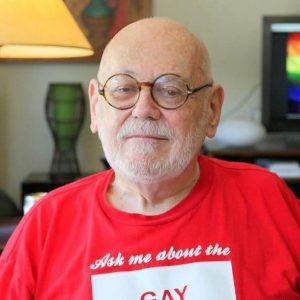
The word “gay” has even been removed from the name “Gay Pride” celebrations by assimilationists, becoming generic “Pride.” Across the country, particularly on college campuses, gay and lesbian identity has been downgraded to an alphabet-soup mishmash like “LGBTQIA+.” Q is for Queer, I is for Intersex, A is for Asexual, and + is for Anything Else That Fits. Is this a hard-fought-for-positive-identity to take pride in or a ludicrous, surreal license plate?
As a result of gay assimilation, in part, once robust gay and lesbian communities and community organizations created in the wake of the 1969 Stonewall Rebellion have atrophied. In West Hollywood, The Abbey, gay-and- lesbian-central in that enclave, is successfully being heterosexualized. In Los Angeles proper, Jewel’s Catch One, a national beacon for gay and lesbian people of color and a successful model of gay community multiculturalism for over 42 years, has closed, becoming a straight establishment. Likewise in L. A., the site of Gene La Pietra’s Circus Disco and Arena Club, also popular and important multicultural safe harbors, has been sold.
Frontiers magazine, once the largest, most vital gay publication in Southern California, laid off its longtime news editor, shriveled into a glossy, shallow entertainment rag and recently ceased publication altogether. For the first time since the 1967 founding of The Los Angeles Advocate, America’s first gay newspaper, Los Angeles’ world-class gay community is without a major community newspaper.
In June 2016 the L.A. Pride celebration accumulated about $400,000 in debt when it largely downgraded the event to a generic music festival–Queer Coachella–focused entirely on the young, becoming just another generic dance
party with no gay political consciousness. In the process, it significantly severed a conscious connection to the Gay Liberation revolution that in 1970 originally initiated the celebration. And we know, anything disconnected from its roots will wither away. In 2017 the anachronistic Pride parade in West Hollywood was replaced by a Resist march, providing the possibility for moving the event in the right political and grassroots and netroots direction in the future–time will tell.
The dumbing-down and sizing-down consequences of the gay assimilation/sexual orientation model, among other factors, are readily visible across the nation.
Gay Essentialism
Putting on a new pair of identity glasses, let’s take a look at Gay Essentialism. We know from the history of science that getting the right answer often depends on asking the right question. We also know from evolutionary biology that a trait is not passed from one generation to the next over time unless it is contributing in some way to the successful survival and evolution of that species. Gay essentialists ask, what are gay people contributing to our species and its social organization that make them reappear generation after generation for millennia while their oppressors go down the drainpipe of history? Is there an unexamined and unacknowledged evolutionary role gay
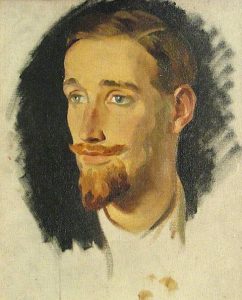
people are playing which is essential to the human species? Evolutionarily speaking, if the primary role of heterosexuals is the reproductive survival of the human species, what is the primary purpose of gay and lesbian people? Is it to mimic heterosexuals? I doubt it. Evolution doesn’t work that way. These questions point in the direction of the gay essentialism/societal contribution model of gay identity.
Gerald Heard, a closeted gay man, former BBC commentator on science, and an expatriate from England with Aldous Huxley and Christopher Isherwood, who lived in Los Angeles, first began raising evolutionary biology questions regarding gay people in homophile publications in 1955, writing under the pseudonym D.B. Vest.
In 1978, E.O. Wilson, a beyond-distinguished Harvard University evolutionary biologist and sociobiologist and a dean of contemporary American science, in his Pulitzer Prize-winning “On Human Nature”, suggested for the first time that gay people may be the rare carriers of the “altruistic impulse” in the human species, i.e., innate carriers of idealism in a way that benefits society and humans’ continuing evolution. Recently, storyteller extraordinaire and author Michael Meade has wisely observed that without idealists a society implodes.
Joan Roughgarden, Stanford University evolutionary biologist, in her important “Evolution’s Rainbow: Diversity, Gender, and Sexuality in Nature and People” (2004), suggests that gay beings are the primary carriers of the “cooperation” principle in nature. Importantly, she was not only commenting about the human species but discovered that contribution also among a wide-range of so-called “gay and lesbian” beings in other species in nature as well. It turns out that from Nature’s perspective, gay people may have as much in common with savanna baboons’ same-sex couplings as they do with their fellow heterosexual humans.
One of the truly amazing and under-reported/non-reported achievements of contemporary science regarding gay and lesbian people was single-handedly accomplished by gay information-specialist Bruce Bagemihl, a non-scientist. Recognizing the strong anti-gay bias in modern science and its failure to support cutting-edge research in the field, on his own he engaged in the Herculean labor of reviewing research articles found only in peer-reviewed scientific journals wherever there was even a whiff of same-sex phenomenology reported. In 1999, taking the scientific community completely by surprise, his encyclopedic “Biological Exuberance: Animal Homosexuality and Natural Diversity” was published. In this stunning, groundbreaking volume, Bagemihl documented over 300 species of vertebrates alone that have same-sex courtship with genital contact. This scientific breakthrough buries forever unfounded and unexamined dogma by societies and religions around the world and throughout history that homosexuality is “unnatural” and needs to be cruelly stamped out by intellectual genocide, like conservative Judaism, Christianity, Islam, Hinduism, and Buddhism today, or physical genocide, like ISIS and its kith and kin, or both.
The Radical Faeries
In 1950 in Los Angeles Harry Hay and several other gay men co-created the historic Mattachine Society which began organized efforts by American homosexuals at self-exploration and societal acceptance. In 1979 in Los Angeles Hay and I, a pioneering Gay Liberationist and a founder of L.A.’s Gay Community Services Center (now the LA LGBT Center), co-founded the Radical Faeries to further the exploration of what a year later was called “gay essentialism” at a conference at the University of Southern California in Los Angeles.
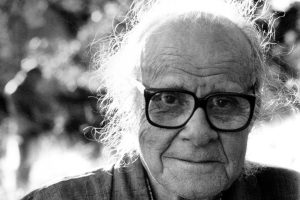
The Radical Faeries grew out of dialogues Hay and I had in Los Angeles during the 1970’s whenever Hay traveled to Los Angeles and along the Rio Grande at Hay’s home adjacent to the San Juan Pueblo in New Mexico (se my “The Birth of the Radical Faeries” in the “Gay and Lesbian Review Worldwide,” September-October, 2010) In late 1969, Hay, with his companion John Burnside, departed Los Angeles to operate the general store on the San Juan Pueblo, where they remained until June 1979, then living in genteel poverty, when I went there, helped pack them up, and brought them back to Los Angeles.
Between 1975 and 1979, I had created workshops for gay men at GCSC in Los Angeles titled “Gay Voices and Visions: The Enspiritment of Gay Politics/The Politics of Gay Enspiritment,” a revolutionarily new form of gay consciousness-raising group. The participants read and discussed together the writings of Walt Whitman, Edward Carpenter, Karl Heinrich Ulrichs, Hay and other gay visionaries, gay-centered poetry and cutting-edge literature from evolutionary biology and the new science of sociobiology–imaginatively bridging gay intellectual history and contemporary scientific research. These workshops provided the intellectual foundation for the Radical Faeries. Indeed, the first Radical Faerie Circle ever organized consisted solely of members of “Gay Voices and Visions” groups in Los Angeles.
From its 1979 beginnings at the first Radical Faerie gathering, attended by over 200 gay men from all over North America, at a remote ashram in the Sonoran desert of southern Arizona, the Radical Faeries grew quickly into an international gay-centered consciousness and spirituality movement. Its decentralized gatherings over the decades had robust vigor, gay-centered spiritual and intellectual exploration and deeply felt sacred brotherhood.In August 2017, 38 years after its founding, a sold-out, international Radical Faerie gathering will be held in Great Britain with the stated goal of creating a global Radical Faerie community. Its aim is to have “queer people step up and claim our freedom and security and human rights, our meaningful and valuable place in society,” echoing the Gay Essentialist intent that originally motivated Hay and I to call the Radical Faeries into being. Thriving residential Radical Faerie sanctuaries also exist in Wolf Creek, Ore.; Zuni Mountain, Ariz.; Short Mountain, Tenn.; Folleterre, France; and Ozland in Australia, among others.
In August 2017, 38 years after its founding, a sold-out, international Radical Faerie gathering will be held in Great Britain with the stated goal of creating a global Radical Faerie community. Its aim is to have “queer people step up and claim our freedom and security and human rights, our meaningful and valuable place in society,” echoing the Gay Essentialist intent that originally motivated Hay and I to call the Radical Faeries into being. Thriving residential Radical Faerie sanctuaries also exist in Wolf Creek, Ore.; Zuni Mountain, Ariz.; Short Mountain, Tenn.; Folleterre, France; and Ozland in Australia, among others.
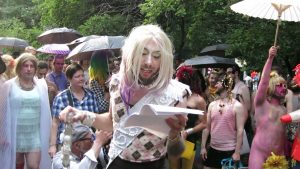
Hay worked largely in isolation in New Mexico, with Burnside’s keen intellectual curiosity and rational analysis serving as his sounding board. Influenced by Gerald Heard, Edward Carpenter and Konrad Lorenz, in 1976
Hay began gradually formulating a proposal that gay men carry a different consciousness than heterosexuals, and that it is this difference in consciousness, rather than sexual behavior per se, that most differentiated gays from straights. He kept working and reworking the contents of this idea up until his death in 2002. He called gay consciousness by the name subject-subject consciousness largely determined by same sex relationships; heterosexual consciousness was labeled subject-object consciousness largely shaped by opposite-sex relational
dynamics.
Hay suggested this difference in consciousness results in differentiation in essential behavior, social organization and societal contribution by gay and nongay humans. Hay’s thinking had been largely formed by extrinsic social determinism, his foundational thinking shaped more by Marx and Engels, rather than intrinsic evolutionary factors. In the trajectory of gay and lesbian intellectual history, his ideas are groundbreaking. The writings of Radical Faerie Will Roscoe, Ph.D., among others, are also an important part of Gay Essentialism literature.
I, from my study of sociobiology and evolutionary biology, also have suggested that gay people contribute to the non-reproductive evolution of our species, playing a “spiritual” role in the broadest possible definition of that word which includes “altruism” (Wilson) and “cooperation” (Roughgarden) at a minimum. A case can be made that gays and straights, rather than being polar opposites, are more like yin and yang, two complementary and supplementary parts of the same whole, the human species. It can be argued that it is the dynamic interaction between this yin and yang cross-pollination that allows, in part, the human species to be an “open” evolutionary system, continuing to evolve.
The Wilson-Roughgarden-Bagemihl-Hay-Kilhefner-and-other breakthroughs need to be intellectually engaged by gay and lesbian people and empirically validated, a sociopolitical task of critical importance for future generations. This essay should not be taken as a final word on anything. It’s barely the beginning word on Gay Essentialism. It is suggested that you approach these ideas, as gay intellectual history itself, with a hungry, insatiable heuristic mind-set.
The 21st century paradigm shift from an old gay assimilation/sexual orientation model to a new gay essentialism/societal contribution model is similar in meaning to the 20th century paradigm shift from Newtonian to Einsteinian physics, a scientific and social revolution causing a radical, fundamental change in how gay people perceive reality, role and identity. It illuminates the unique and essential way in which gay people see and move in the world, select careers and social roles, and contribute to society for the benefit of all beings.

Thank You for your depth and perspective.